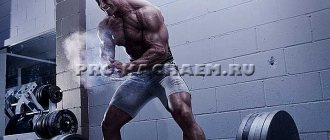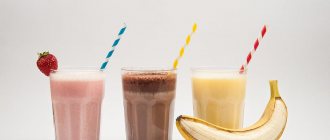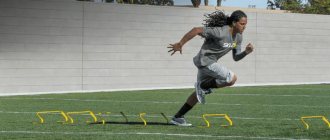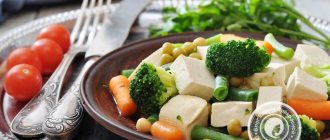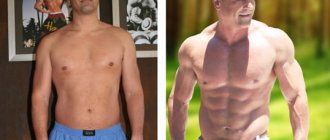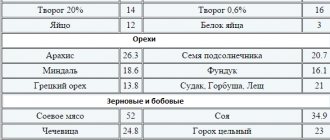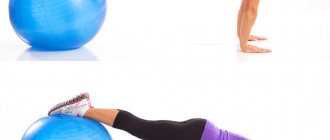Why is a carbohydrate window necessary when losing weight?
Every person has encountered a ravenous appetite after good physical activity, for example, after the usual digging of beds.
During this period, hunger becomes especially strong, which is why you can eat a lot of things. This is how the anabolic (carbohydrate) window manifests its effect - the period of time after a high-intensity load. During this period, the body is able to quickly absorb and metabolize carbohydrates. It would be more correct to say a carbohydrate-protein window, since after a workout, not only carbohydrates, but also proteins help to launch recovery processes. During this short period, the athlete experiences an urgent need for fuel. Many novice athletes do not use the post-workout carbohydrate window to lose weight, and in vain, since it has many beneficial properties:
- increases the level of glucose in the blood, due to which proteins are absorbed faster, which promotes muscle gain and fat burning;
- neutralizes catabolic processes and the production of the stress hormone cortisol, which provoke the breakdown of muscle fibers;
- restores glycogen reserves in the liver and muscles;
- prevents the breakdown of muscle tissue (they consume more calories throughout the day, due to which a person loses weight);
- provides the opportunity to eat your favorite foods, for example, sweet fruits or marmalade, without compromising your figure, due to which a person can avoid breakdowns.
Fitness myths: protein-carbohydrate window after exercise
Is there a protein-carbohydrate (anabolic) window after training?
The basic idea is this: After strength training, your muscle fibers are damaged and your glycogen stores are depleted. By eating a mixture of protein and carbohydrates as quickly as possible after exercise, you offset these effects, so your body can quickly build more muscle. And it is believed that this magical state lasts only 30-40 minutes, and then the window closes, and whoever didn’t have time is late. Without closing the anabolic window, you will not build muscle, and your workout will be wasted.
Thanks to the efforts of the sports nutrition industry, newcomers especially often fall into this trap because they love to try on the nutritional regimens of elite athletes on steroids.
Anabolic window - only after training on an empty stomach
One of the ideas that formed the basis of the “anabolic window” is accelerated muscle breakdown after exercise, which must be quickly stopped. But in fact, the rate of muscle breakdown after strength training is only slightly increased (). Therefore, eating immediately after training will not play a huge role.
The exception to this rule is training on an empty stomach, when you do not eat for 4-5 hours or more. In this case, the breakdown of muscle protein increases significantly, so eating immediately after training is a good strategy ().
Moreover, all studies that show the existence of a protein-carbohydrate window were conducted specifically on athletes training on an empty stomach.
That's why what and when you ate during the day before training plays a decisive role.
Food is digested slowly, and the mere fact of an empty stomach does not mean that there are no nutrients in the blood. All of them enter the blood within 4-5 hours after you eat. So if your meal was 2-3 hours before training, you already have both proteins and glucose in the system, and there is no point in eating something before and immediately after training.
In this case, if possible, you should eat something protein-carbohydrate immediately before training. Not only will you get some amino acids into your bloodstream, which will be available during and immediately after your workout, but a small amount of carbohydrates will ensure that your glucose levels are stable and you have enough energy to get going. This option is also suitable for those who do not have the opportunity to eat immediately after training.
If you start your workout on an empty stomach (more than 3-4 hours after your last meal), you should eat 25-30 grams of protein immediately after your workout.
Lyle MacDonald gives the following figures:
If 3-4 hours have passed since your last meal, 30 minutes before training you should take a mixture of proteins and carbohydrates to normalize blood glucose levels and get some amino acids: 0.3-0.5 g/kg of both carbohydrates and protein will be a good starting point dot. Post-workout: 0.3-0.5 g/kg protein and 0.3-1.5 g/kg carbohydrates.
So, if your last meal was 2-3 hours before your workout, your body is still using the amino acids it provides for muscle repair and growth.
An in-depth review of research into the anabolic window was conducted in 2013. One of the main things that scientists have discovered is that there is no convincing evidence that consuming carbohydrates and protein immediately after exercise increases muscle protein synthesis.
When it came to building lean muscle mass, protein timing didn't matter. In all the studies where participants consumed protein immediately after exercise, the results were slightly better, it turned out, simply because they consumed more total protein per day.
The anabolic window lasts a day
According to a study conducted by the Department of Kinesiology at McMaster University, Hamilton, Ontario, protein synthesis is increased within 24 hours after strength training ().
Muscle protein synthesis increases in the human body by 50% 4 hours after strength training, and by 109% after 24 hours, and then rapidly decreases, returning to baseline levels after 36 hours.
Thus, it is important that you eat within 1-2 days after training, and not within half an hour after it. The total amount of protein and carbohydrates throughout the day is critical (). This means you can't rely solely on post-workout protein and the mythical protein-carbohydrate window for muscle growth. Nutrition throughout the day plays an important role. The only exceptions would be elite athletes or people who train several times a day, as well as those who train on an empty stomach.
Mechanism of action
There is controversy regarding the length of the window. According to some sources, it lasts 45–90 minutes, according to others – 20–35 minutes. For this reason, it is better to close the carbohydrate window after a workout for weight loss immediately. This is recommended by many diet and sports experts. The essence of strength and cardio exercises is the destruction of existing muscle fibers, which are then restored, grow and increase in size. After intense exercise, the following happens in the body:
- Compensatory mechanisms are activated. They promote muscle recovery. Only without food does the body draw reserves for regeneration from the muscle tissue itself.
- Improves the absorption of protein necessary for muscle growth. During the day, this nutrient is absorbed differently. After a workout, the protein window also opens, so it is useful to consume protein at this time.
- For a short time, the body has the ability to quickly absorb and metabolize carbohydrates. They go to restore the body. Also, simple carbohydrates after a workout for weight loss are effective because they prevent the launch of catabolic processes associated with the production of the hormones cortisol and adrenaline. They are blocked by insulin, the level of which rises when consuming carbohydrate foods.
Why you need to eat after a workout
The answer is simple - you need to eat after exercise to provide the body with energy for muscle recovery. Otherwise, he will begin to use his own muscle tissue as energy reserves, and this will lead to the accumulation of subcutaneous fat. It is worth noting that during the period of weight loss for fat burning after exercise, it is better to consume proteins rather than fast carbohydrates. The reason is that carbohydrate foods reduce to zero the production of growth hormone, which has a fat-burning effect. When you eat protein instead of carbohydrates, the following will happen:
- The necessary amino acids will enter the blood.
- The production of the stress hormone cortisol will stop.
- Protein synthesis will begin, so the muscles will begin to recover, but the insulin level will not jump, which provokes the deposition of excess fat.
What is the carbohydrate window?
The carbohydrate window is a short period of time (30-45 minutes) after intense physical activity, when the body is especially in dire need of replenishing expended resources. This is the process of eliminating metabolites that have accumulated in tissues and eliminating oxygen debt.
During an intense workout lasting at least 45 minutes, the body loses water and nutrients. After completing a workout, the body needs to replenish not only fluid, but also the glycogen expended by the muscles. It is necessary to replenish macronutrient reserves in a short period of time. To do this, immediately after training you need to eat so-called “fast carbohydrates”.
50 developmental exercises for training at home
In a nutshell, this is what happens in the body during intense physical activity: the levels of adrenaline and cortisol increase, which continue their effect after exercise, destroying protein (muscle) tissue. To prevent this muscle shrinking effect, it is important to use another hormone - insulin. It neutralizes the destructive effects of cortisol, as it is its biochemical antagonist. And this very insulin is produced in the body of a healthy person when consuming “fast carbohydrates”.
Many people have heard the term “protein-carbohydrate window”. A little clarification is needed here. In addition to carbohydrates, the body also needs proteins after a hard workout. Physical recovery depends on the amino acids that make up protein. Carbohydrates are needed to restore energy, and protein is needed to restore muscle structure. As sports nutritionists note, during the carbohydrate window it is best to include both carbohydrate and protein foods (for example, sports protein shakes).
How to close the carbohydrate window
During the period of weight loss, it is better to avoid fast carbohydrates, since they provide only a temporary feeling of fullness and a surge of energy. Within half an hour, insatiable hunger will reappear, and your energy level will drop sharply. For drying (improving body contour), normal metabolism is important, and this is incompatible with sweets and baked goods. Carbohydrates with a low glycemic index are beneficial:
- vegetables;
- durum wheat pasta;
- baked or boiled potatoes;
- any cereals;
- peas, beans;
- whole grain bread products;
- chicken fillet.
During cutting, when you need to burn the maximum amount of fat and preserve muscle tissue, it is better to consume protein before consuming carbohydrates. Complex amino acids, whey protein hydrolysate or regular egg whites will help replenish its smell. To provide the body with energy more quickly, simple carbohydrates are better suited, but these are not those harmful cakes or flour products. Instead, it is recommended to use:
- marshmallows;
- marshmallow;
- honey;
- chocolate;
- banana;
- grape;
- marmalade
After strength training
To lose weight after strength training, you need to “throw in” fast carbohydrates in combination with high-value proteins. It is better to consume foods in liquid form, such as cocktails or other drinks. Among carbohydrates, you should choose those that have a high glycemic index, for example:
- jam;
- jams;
- condensed milk;
- bananas, kiwi, apples;
- Brown sugar;
- jam;
- dates;
- raisin.
If you burn 500 calories after strength training, you can eat no more than 250 kcal. You shouldn’t give up protein foods, but you shouldn’t overdo it with their quantity. To provide the body with protein, many athletes use special protein shakes. In addition to sports nutrition, you can include in your diet:
- milk;
- lean poultry;
- oats;
- lentils;
- egg white;
- fish fillet.
After cardio
Compared to strength training, cardio (aerobic) exercise does not contribute to intensive muscle building. They only tone the muscles, after such training it is also necessary to close the carbohydrate window. It is necessary to consume carbohydrates after cardio within half an hour. Better in the first 20 minutes. eat the proteins first. The calorie content of foods should not be high. To close the protein window, cottage cheese, kefir, eggs are suitable, and for carbohydrates - fruits, bread, nuts, dried fruits. The main thing is not to overdo it, so as not to cause heaviness in the stomach.
Conclusions and practical recommendations[edit | edit code]
Based on the general lack of data, as well as the inconsistency of experiments and results obtained, it is quite difficult to draw specific practical conclusions on the intake of nutrients before and after training, however, the authors were able to provide the following conclusions:
- There are no studies comparing the effectiveness of nutrients taken before and after a workout, so it is impossible to say whether the pre-workout or post-workout period is more important.
- Based on scientific and experimental data, for muscle hypertrophy, you should take a high-quality protein (for example, whey, egg, beef) at a dose of 0.4-0.5 g per kg of body weight (that is, an average serving of 20-40 g
).[17] [18][19] This must be done both before and after training. Exceeding the specified dose is not advisable. - Due to the short-term anabolic effects of protein foods and synergism with physical activity, the time interval between pre-workout and post-workout meals should not exceed 3-4 hours. If the source of protein is not sports nutrition, but a large intake of mixed food, then the time interval can be extended to 5-6 hours.
- Provided that the average training duration is 45-90 minutes, the protein-carbohydrate window lasts approximately 1.5 hours before the start and 1.5 hours after
the end of the exercises. - The training session can be shifted closer to the pre-workout or post-workout consumption of food or sports nutrition, while maintaining an interval of 3-4 hours between them. This strategy covers all the needs of the body and at the same time has maximum flexibility, that is, it can be adapted to the specific nutritional conditions of the athlete. Time frames may vary depending on individual preference, tolerance and length of training.
Carbohydrates[edit | edit code]
The situation with carbohydrates is even less clear and is still a dark spot from a scientific point of view. The lack of consolidated data does not allow us to draw any clear conclusions. It is generally recommended to include carbohydrates both before and after training in amounts approximately equal to or greater than the protein consumed along with them.
However, the availability of carbohydrates during and after training is a more important factor for endurance than hypertrophy and strength. Moreover, the importance of combining protein and carbohydrates post-workout has recently been called into question by several studies that examined the post-workout recovery period accompanied by protein intake without carbohydrates.
Koopman et al[20] found that after whole-body resistance training, carbohydrate supplementation (0.15 or 0.6 g/kg body weight) had no effect on total body protein balance (including muscle) for 6 hours post-exercise, compared with only protein intake. Then Staples[21] published a paper showing that after strength training the legs, the increase in muscle protein synthesis with 25 g of whey isolate was exactly the same if athletes also took an additional 50 g of maltodextrin.
Thus, in bodybuilding, only the total quantity and quality of carbohydrates consumed per day matters, while time is of secondary importance.
Recipes for protein-carbohydrate dishes
If your workout occurs in the morning, you can consume carbohydrates to lose weight. Protein smoothies are more suitable for covering carbohydrate protein in the evening. It is also possible to mix proteins with carbohydrates, but in the evening it is better to avoid sweet foods and high-calorie ingredients. When choosing a specific recipe, you need to focus on calorie content. It should not be more than 50% of those burned during training.
Banana milkshake
This is one of the easiest smoothie recipes that you can use to close the carb window after a workout for weight loss. You can drink it both in the morning and in the evening, using it as a light dinner. For taste, you can flavor the cocktail with cinnamon or ginger. These spices have a fat-burning effect and help cleanse the body of waste and toxins. Banana can also be used for garnish by adding a few slices to the top of the smoothie.
Ingredients:
- skim milk – 300 ml;
- ripe banana – 1 pc.
Cooking method:
- Peel the banana, chop and place in a blender.
- Pour milk into it, preferably chilled.
- Beat the drink until smooth and foamy.
Carbohydrate smoothie with kiwi, mango and honey
This cocktail has a very unusual taste thanks to the combination of kiwi and mango. The latter fruit provides the body with many vitamins, relieves heartburn and even relieves stress. No less useful is kiwi, which contains beta-carotene, fiber, pectin and magnesium. This fruit promotes weight loss due to the antioxidants in its composition, but they are present in the skin, so it can also be consumed.
Ingredients:
- mango – 150 g;
- skim milk – 300 g;
- kiwi – 2 pcs.;
- honey – 1 tbsp.
Cooking method:
- Peel the fruit, you can leave the kiwi with the skin.
- Cut them into small cubes, place in a blender bowl, and blend.
- Pour in cold milk and beat the ingredients again.
- Then add honey. Whip the smoothie one last time until smooth.
Cottage cheese cocktail with oatmeal
Oatmeal is a representative of slow carbohydrates, which ensures satiety and vigor for 3-4 hours. Cottage cheese is good for metabolism, and it is also slowly absorbed. In addition, the body expends a lot of energy to process this dairy product. As a result, for several hours after eating cottage cheese, calories are spent on it.
Ingredients:
- skim milk – 0.5 tbsp.;
- cottage cheese with fat content 1% – 200 g;
- banana – 1 pc.;
- oat flakes – 100 g.
Cooking method:
- Cut the banana into pieces and place in a blender bowl. Grind until smooth.
- Add the cottage cheese mashed with a fork. Beat everything again.
- Pour in the cereal and pour in the milk. Beat one last time until smooth.
Which carbohydrate sources to choose?
To increase insulin release and speed up glycogen production, you need your blood sugar to rise quickly. Therefore, leave fruits, vegetables and cereals for another time: fiber slows down the absorption of carbohydrates. Chocolates, cakes and fast food are also not suitable, because in addition to fast carbohydrates they contain a lot of fat.
Choose foods with a high glycemic index (GI) - those that quickly raise blood sugar, but without an abundance of fat: sweet drinks, marmalade, honey, marshmallows. These are pure carbohydrates with a high GI. Just remember that you also need 20 grams of protein.
You can wash down the marmalade with a powdered protein shake, add three tablespoons of honey to the drink, or prepare a protein-carbohydrate shake from ordinary products and take it with you to training.
For those who are accustomed to simple solutions, there are gainers - ready-made protein-carbohydrate drinks. They contain about 75 grams of carbohydrates and 15 grams of protein per 100 grams of drink. You simply dilute it and drink it after your workout.

